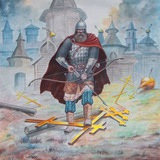
Telegram-канал aryanpaganism - Aryan Paganism, Traditions and Art (APTA)
 8417
8417
A place for Aryan (European) Folkish Pagans

 8417
8417
A place for Aryan (European) Folkish Pagans

Bridge of Kings
Felix Ortiz

Zadorozhnyj designed the interior of a restaurant "Bratina" in Kyiv made in Slavic Pagan style
Читать полностью…
Attila the Hun by Valentyn-Ivan Zadorozhnyj
Читать полностью…
New art by Brother Bjorn
https://x.com/bjorn_brother

Bellerophon fights Chimera
Arthur Rackham

Nice illustration, a shame there’s no better photo online
Читать полностью…
The latter point is where the first trait comes in. It’s possible that the giants are helping humans who would be the ones struggling with rough terrain or raging rapids.
Also, in the tales the trio supports a young hero. Though that’s where their giant size disappears and they start acting like typical incompetent allies many folk tales have. Must have been some mix up of the original minor roles getting expanded ironically loosing their characteristics.

The third giant is Water-Turner. His domain is rivers which he separates with his extremely long moustache.
Читать полностью…
I chose Svyatogor as an example since he combines all three traits, but he is not the best example of the second one. There are other giants, a group of three to be exact, who are much more representative of the elemental nature. Their names differ slightly and can be translated. I’ll just pick the best-sounding option.
The first is Oak-Turner. As the name implies he uproots (upturns if you will) oaks, turning forests into valleys.

2. Elemental nature
Giants in Slavic folklore all have at least some connection to the elements. Svyatogor himself has -gor in his name which means mountain. He mentions that mountains are the only place he can dwell at since ground is not strong enough to support his weight. Svyatogor can also resemble a mountain due to his size.

Svyatogor has all of the common defining traits giants share in Slavic folklore which are:
Читать полностью…
While not as prevalent as in the folklore of British Isles giants do appear in Slavic tales, but they differ to the point where one could use a different term to describe those beings such as velet or volot. Still, it’s big and human-looking so a giant it is.
Читать полностью…
Zeus with the shield and lightning
Читать полностью…
Zeus with his thunder and aegis shield
Читать полностью…
German wearing a polar bear coat by Hermann Katsch
Читать полностью…
European stone sculptures by Halyna Sevruk
Читать полностью…
Attila by Valentyn-Ivan Zadorozhnyj
a better photo

Nice Medieval-style illustrations of the tale of Mykyta the Tanner by Valentyn-Ivan Zadorozhnyj
Читать полностью…
There are different schools of thought when it comes to the intrigal parts of one's being in Germanic Faith.
Some say there are three, while others say there are nine. From my research, I have been able to discern twelve.
Ọnd: akin to breath/ vitality, one could also say potential or spirit.
Óð: these would be your senses of perception.
Lá: heat from within that keeps you alive.
Lito Góða: goodly-hue or healthy skin color.
Lík: the physical body which remains after death.
Hugr/Minni: thoughts & memories.
Hamr: akin to one's form, shape or blueprints that don't change such as sex, birthmarks etc.
Fylgja: commonly thought of as an animal-spirit of one's self/ family & is typically a guardian of sorts.
Hammingja: this is one's luck which is always present & can be built up or degraded through honor or lack thereof.
Læti: this is often translated as motive force or the actualizing of potential.
Họfðo: this is blood, but also one's genetics which ties to the ancestors & descendants.
Örlög: one's fate.

Here’s to all Pagan couples having a good day. Let us hope that this year more men and women come together bound not only by love but faith too.
Читать полностью…
Terraforming and elemental nature have become a focus of many modern reconstructions of Pagan belief. Such ideas are not unprecedented, though by the time most epic tales were written down giants were already rare in folklore.
Читать полностью…
What’s noteworthy is that the three giants are engaged in what can be called terraforming. Making the wilds into passable land. It’s hard to say why exactly they do it since for someone as big as them even the widest of rivers, the highest of mountains and the most dense forests pose no issue.
Читать полностью…
The second giant is Mountain-Turner. Same as the last one, but he deals with mountains.
Читать полностью…
3. Age
Most giants are at least implied to be old. Svyatogor is a good example. Also there’s a short, but peculiar story about a young giant finding some of the first humans and being really surprised by their size. He brings them to his mother who prophesies that despite their weakness humans will replace giants.

1. Helpful nature
Unlike the giants fought by British or Welsh heroes Slavic ones are not antagonistic. Svyatogor for example befriends Ilya of Murom, shares some of his strength and leaves his sword to the hero.

The first and most characterized giant on the list is Svyatogor whose story I have already retold (in prose) and analyzed before.
Read here: /channel/Aryanpaganism/6282

Want to write a deep dive into giants in Slavic folklore and epic poetry. Not sure, but it may take more time than usual. Comment if you like the idea.
Читать полностью…
6th c. BCE depiction of the Gigantomachy
Читать полностью…
There’s a saying in Eastern Slavic countries that only wolves get married during Yuletide therefore there was no marriages celebrated during the holiday season.
Читать полностью…
Pagan artisan Anton L. Vognedar teaching kids how to make idols
Читать полностью…